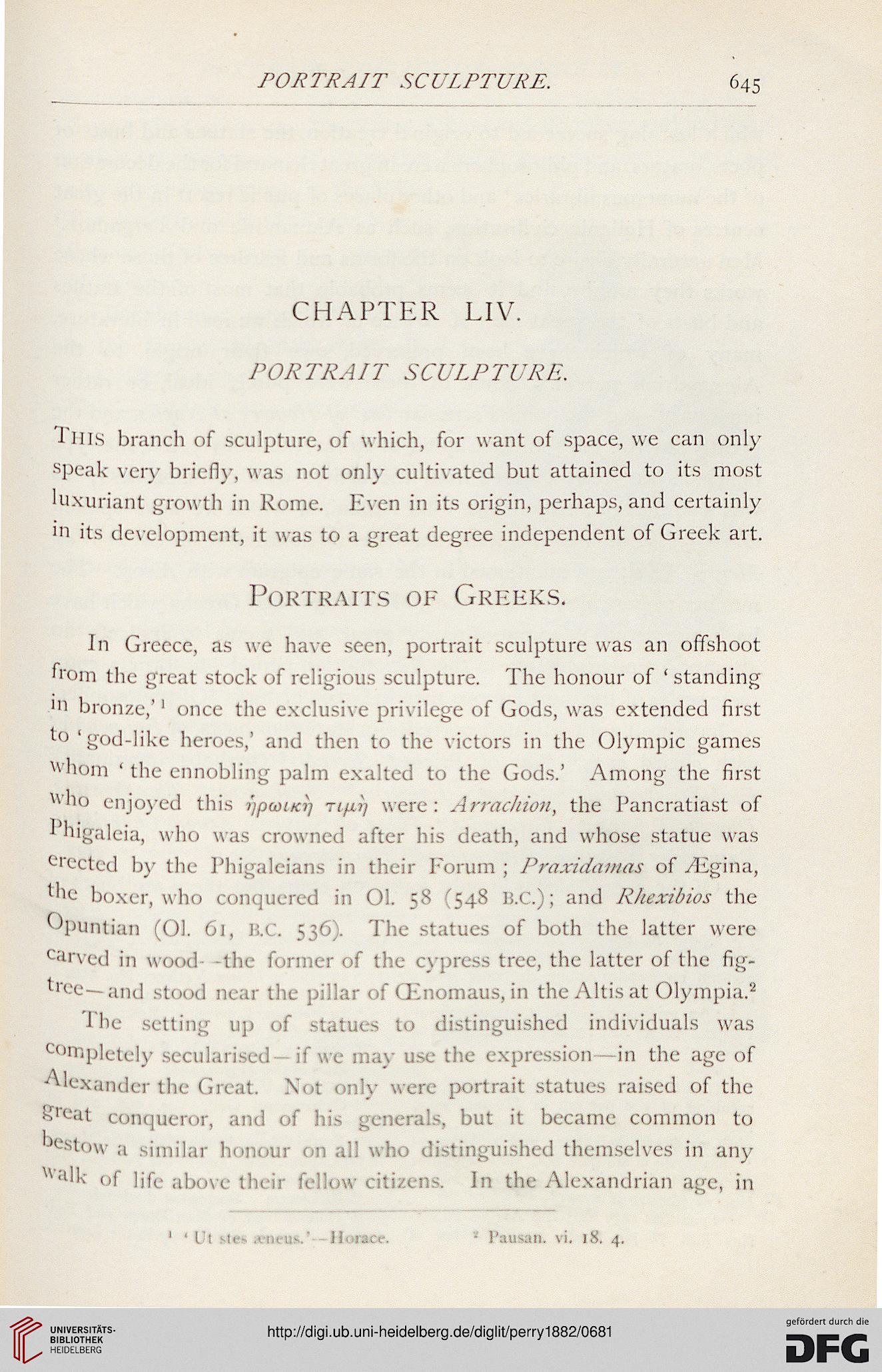C'45
CHAPTER LIV.
PORTRAIT SCULPTURE.
Tills branch of sculpture, of which, for want of space, wc can only
speak very briefly, was not only cultivated but attained to its most
luxuriant growth in Rome. Even in its origin, perhaps, and certainly
in its development, it was to a great degree independent of Greek art.
Portraits of Greeks.
In Greece, as we have seen, portrait sculpture was an offshoot
from the great stock of religious sculpture. The honour of ' standing
"i bronze,'1 once the exclusive privilege of Gods, was extended first
to ' god-like heroes,' and then to the victors in the Olympic games
WilOm ' the ennobling palm exalted to the Gods.' Among the first
who enjoyed this i}pcoiicT] ti/mj] were: Arrachum, the Pancratiast of
* higaleia, who was crowned after his death, and whose statue was
erected by the Phigaleians in their Forum ; Praxidamas of yEgina,
the boxer, who conquered in 01. 58 (548 B.C.); and Rkexibios the
Opuntian (Ol. 61, H.C. 536). The statues of both the latter were
carved in w ood- -the former of the cypress tree, the latter of the fig-
trce— and stood near the pillar of G£nomaus, in theAltisat Olympia.2
I be setting up of statues to distinguished individuals was
Completely secularised— if we may use the expression—in the age of
Alexander the Great. Not only were portrait statues raised of the
sreat conqueror, and of his generals, but it became common to
bestow a similar honour on all who distinguished themselves in any
Xv,ilk of life above their fellow citizens. In the Alexandrian age, in
CHAPTER LIV.
PORTRAIT SCULPTURE.
Tills branch of sculpture, of which, for want of space, wc can only
speak very briefly, was not only cultivated but attained to its most
luxuriant growth in Rome. Even in its origin, perhaps, and certainly
in its development, it was to a great degree independent of Greek art.
Portraits of Greeks.
In Greece, as we have seen, portrait sculpture was an offshoot
from the great stock of religious sculpture. The honour of ' standing
"i bronze,'1 once the exclusive privilege of Gods, was extended first
to ' god-like heroes,' and then to the victors in the Olympic games
WilOm ' the ennobling palm exalted to the Gods.' Among the first
who enjoyed this i}pcoiicT] ti/mj] were: Arrachum, the Pancratiast of
* higaleia, who was crowned after his death, and whose statue was
erected by the Phigaleians in their Forum ; Praxidamas of yEgina,
the boxer, who conquered in 01. 58 (548 B.C.); and Rkexibios the
Opuntian (Ol. 61, H.C. 536). The statues of both the latter were
carved in w ood- -the former of the cypress tree, the latter of the fig-
trce— and stood near the pillar of G£nomaus, in theAltisat Olympia.2
I be setting up of statues to distinguished individuals was
Completely secularised— if we may use the expression—in the age of
Alexander the Great. Not only were portrait statues raised of the
sreat conqueror, and of his generals, but it became common to
bestow a similar honour on all who distinguished themselves in any
Xv,ilk of life above their fellow citizens. In the Alexandrian age, in




